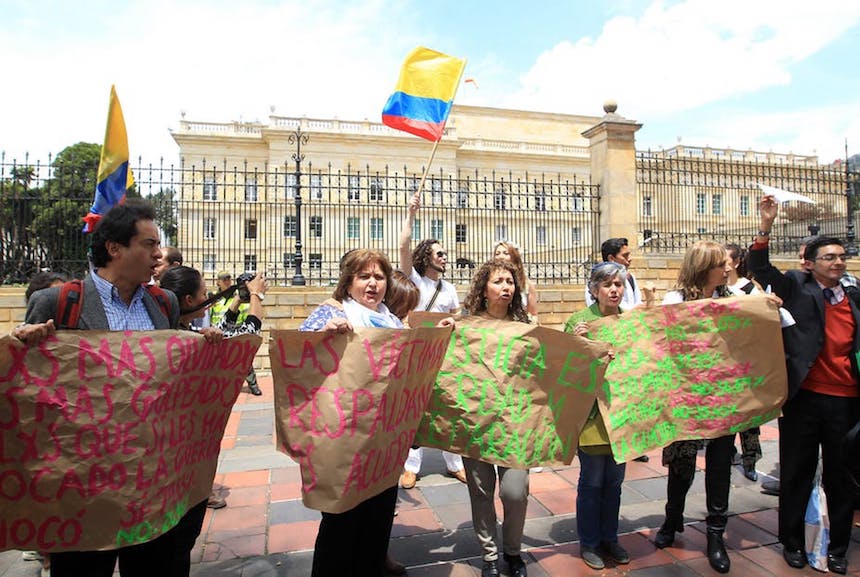 Colombia’s president, Juan Miguel Santos, won a Nobel Peace Prize for striking a peace deal with the FARC guerrillas after decades of conflict. But now his government is charged with putting the deal into action – and with parliamentary and presidential elections coming up in 2018, the clock is ticking.
Colombia’s president, Juan Miguel Santos, won a Nobel Peace Prize for striking a peace deal with the FARC guerrillas after decades of conflict. But now his government is charged with putting the deal into action – and with parliamentary and presidential elections coming up in 2018, the clock is ticking.
Some advances have been made; the members of Colombia’s Truth Commission have at last been elected, and the Constitutional Court has finally given the Special Jurisdiction for Peace (JEP), a body meant to try those responsible for human rights violations, the go-ahead. But for all that these look like steps forward, the reality is more worrisome. The demobilisation of the FARC proceeded slowly, as did the approval of the JEP. These difficulties have not only bogged the peace process down, but eroded the population’s trust in both the government and the settlement.
There are other problems too. The Constitutional Court only approved the JEP with some far-reaching last-minute changes. Although previous justice processes have demonstrated how big a role business and industry played in the conflict, the Constitutional Court chose to downgrade these third parties’ participation in the JEP from mandatory to voluntary. This will not only narrow the scope of justice, but also limit the resources for reparations to victims, which are meant to be partly provided by perpetrators.
On another front, the Senate recently decided that human rights lawyers who have previously defended conflict victims are no longer eligible to serve as JEP magistrates. This affects several magistrates already appointed, and raises doubts about just how committed the state is to the victims.
Hard truths
Then there’s the proposed Truth Commission. Many consider it a crucial device for establishing a unified narrative of the conflict, but what is it really going to do that hasn’t been done before? Colombia’s National Centre for Historical Memory has already produced a wealth of reports about many aspects of the conflict, with survivors’ experiences prominently featured. As for the wider “historical truth” that the commission is meant to clarify, attempts have already been made by the Centre’s 2014 “Basta Ya!” report and by the academics of the Historical Commission on the Conflict.
More worryingly for the commission’s advocates, the truth commissions held in places as diverse as South Africa and Peru show that survivors expect more than the “collective catharsis” that truth commissions promise to deliver. Simply testifying can be far from healing for survivors, especially when they continue to suffer the poverty and insecurity the conflict caused them.
So what will these peace and justice measures actually achieve? Survivors’ experiences suggest that their key concerns are security and access to basic public services. The infrastructural and development services for reintegration camps and surrounding communities are being set up disappointingly slowly. This is slowly but surely eroding people’s already brittle trust in the state.
The same goes for the efforts to tackle Colombia’s drug problem. The forced coca eradication campaign is not matched by a similar commitment to implement coca substitution projects or improve the infrastructure needed to commercialise new crops. The persistent insecurity caused by the FARC has in fact increased, with other illegal armed groups filling the vaccuum; more than 200 civil society leaders have been killed since 2016.
Making peace a reality
For peace and reconciliation to take hold, people need the basic conditions that support a dignified life. In a country like Colombia, where the state has been historically all but absent from conflict-hit rural areas, this requires proper structural transformations.
The state’s planned “transformation of the rural sector” will be implemented by the recently created Agency for the Renovation of the Territory. The plans will target 170 municipalities in 16 subregions, but they are far from comprehensive; they fail to include historically abandoned regions such as Magdalena, where I conducted my own research. And as the prestigious Kroc Institute for International Peace Studies recently noted, there is little sign of these and other measures actually being implemented.
Colombia has a tendency to tackle problems by creating new institutions, laws and programmes, but that is not enough to restore trust. Rather than investing in an ever more complicated legal and institutional framework to provide peace and justice, the government must strengthen the existing state institutions needed to provide basic public services and security.
![]() The gap between survivors’ needs and what’s currently provided must be closed. If these laws and policies don’t change living conditions on the ground, this hard-won peace could turn out to be mere performance – and for all the good it’ll do Colombia’s international image, that will be a sad disappointment for many of the conflict’s millions of survivors. As one community leader I worked with put it: “There is peace, but we continue to suffer, so we don’t know what peace really means.”
The gap between survivors’ needs and what’s currently provided must be closed. If these laws and policies don’t change living conditions on the ground, this hard-won peace could turn out to be mere performance – and for all the good it’ll do Colombia’s international image, that will be a sad disappointment for many of the conflict’s millions of survivors. As one community leader I worked with put it: “There is peace, but we continue to suffer, so we don’t know what peace really means.”
Sanne Weber, Research fellow at the International Development Department, University of Birmingham
This article was originally published on The Conversation. Read the original article.

